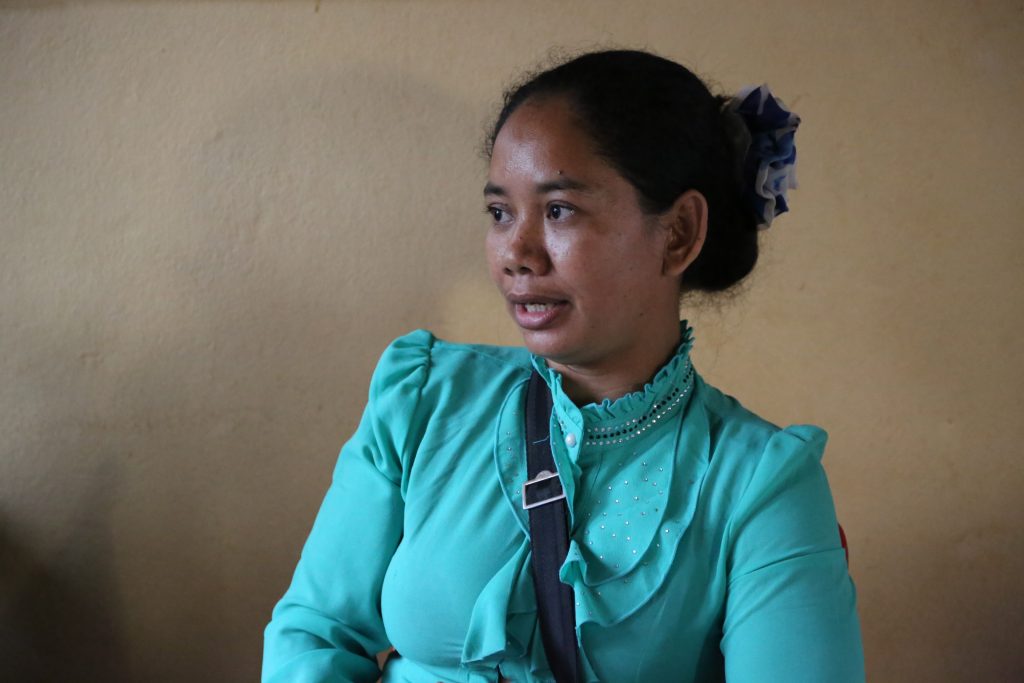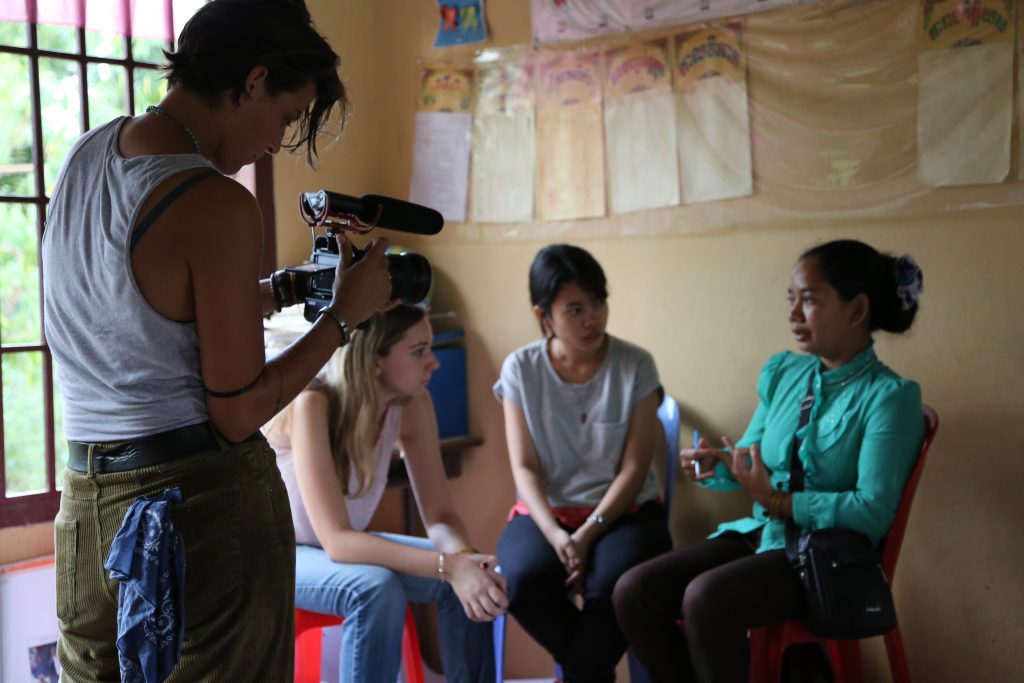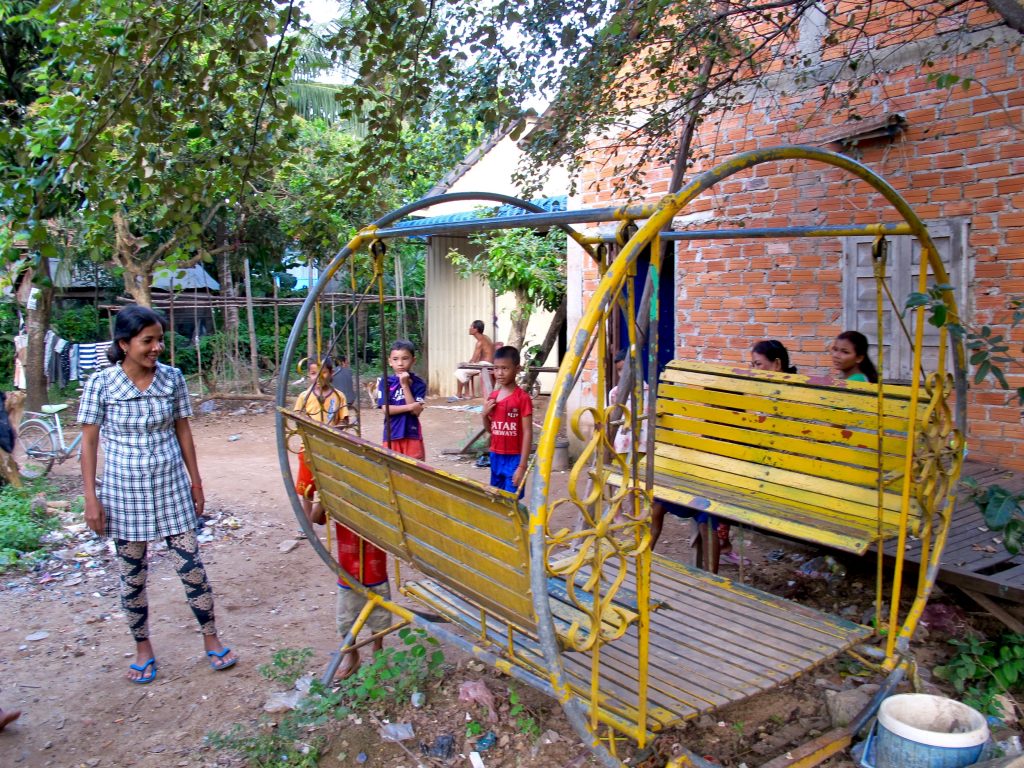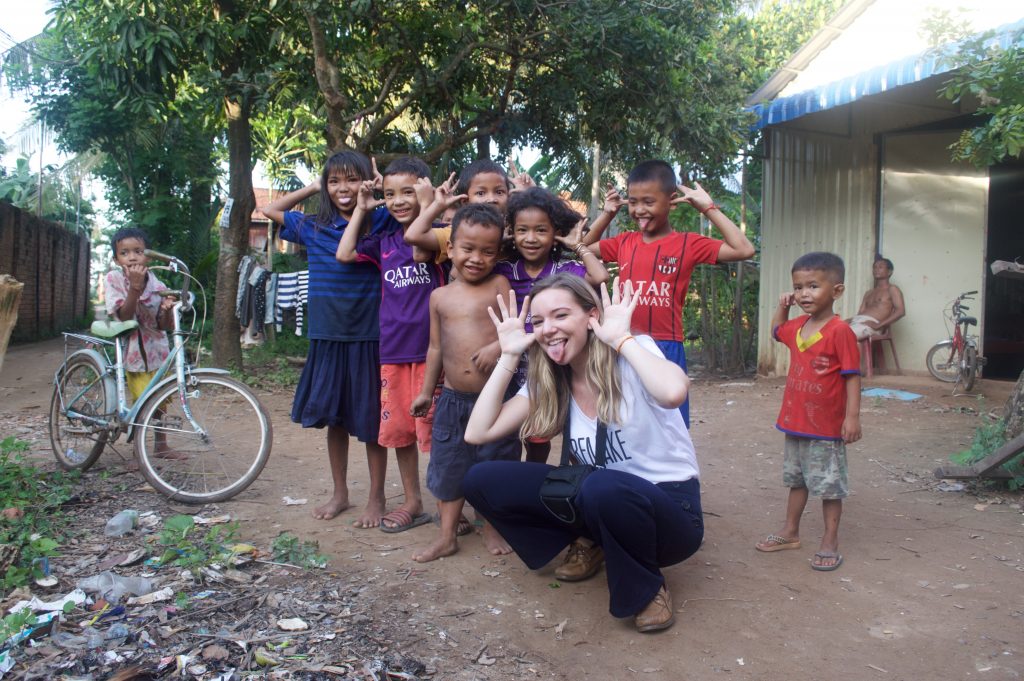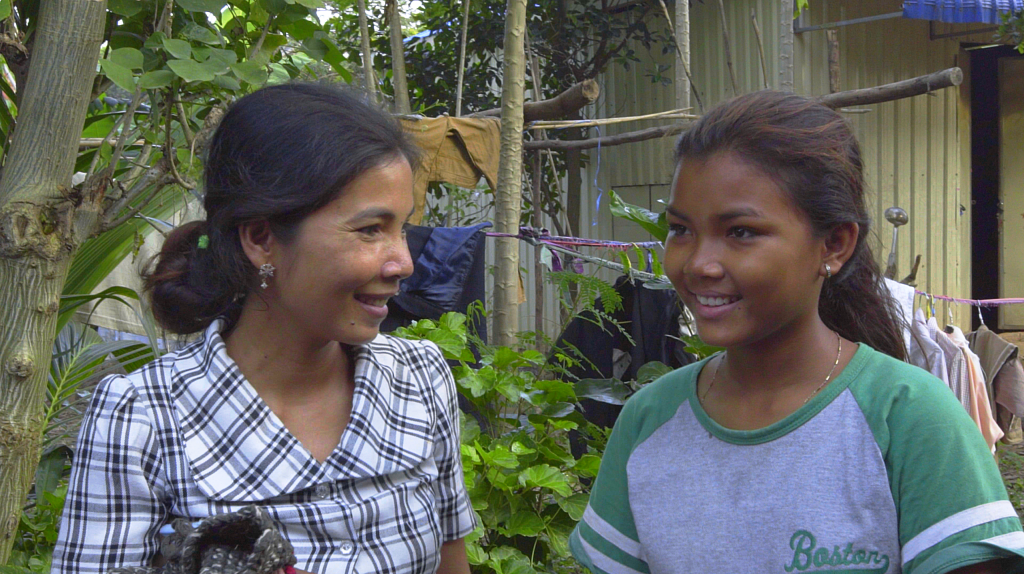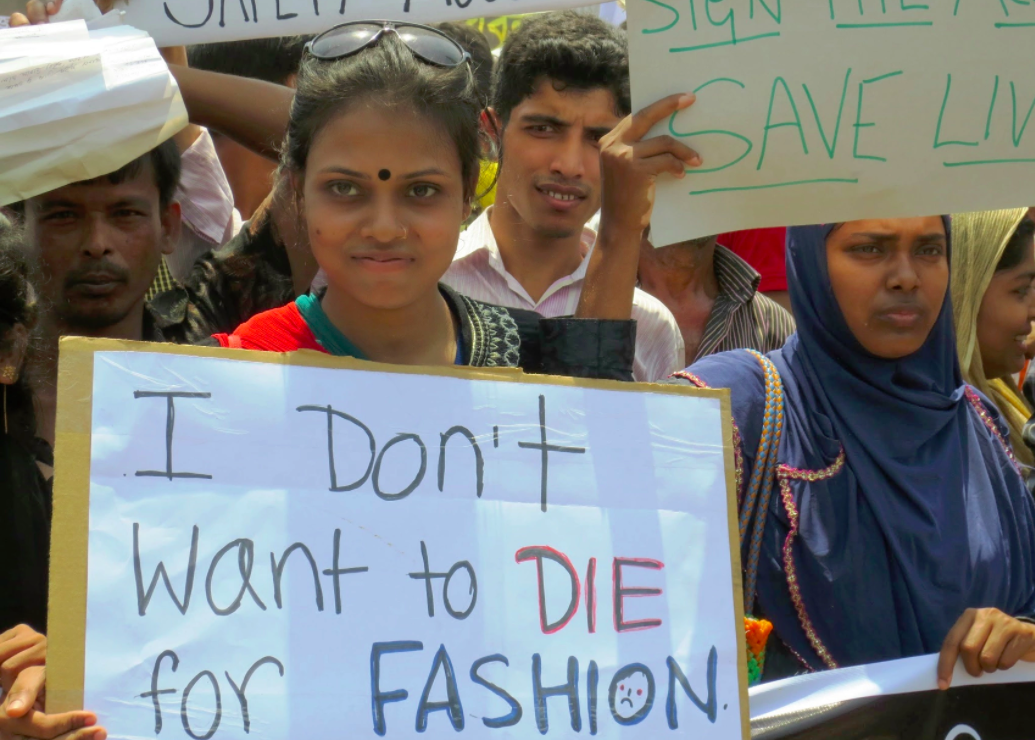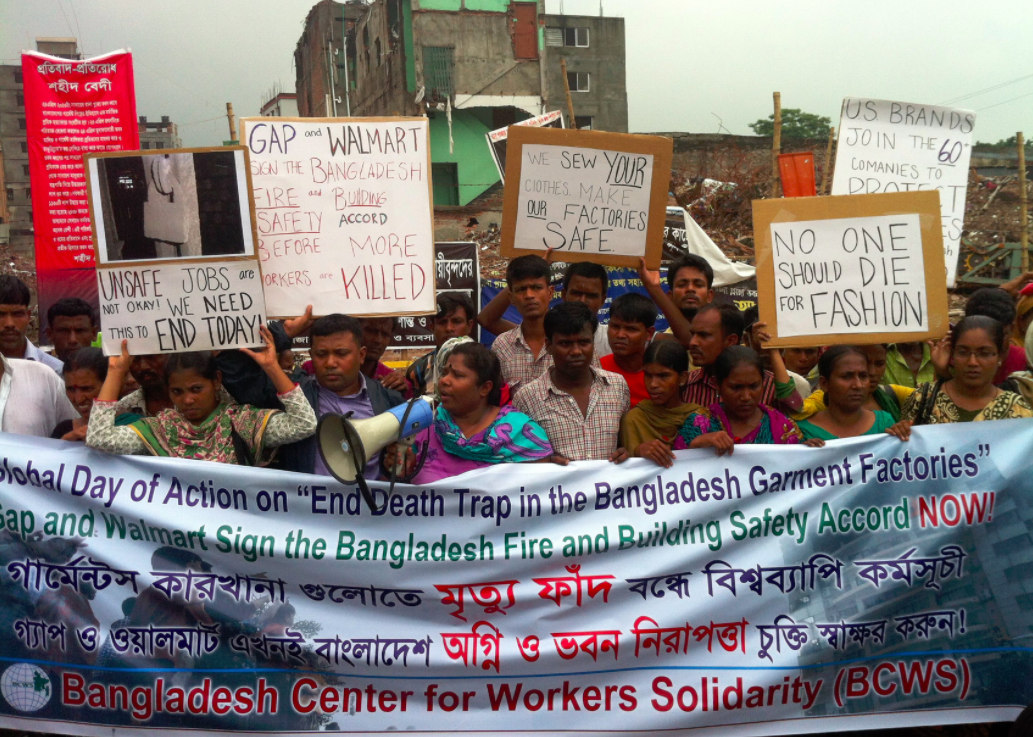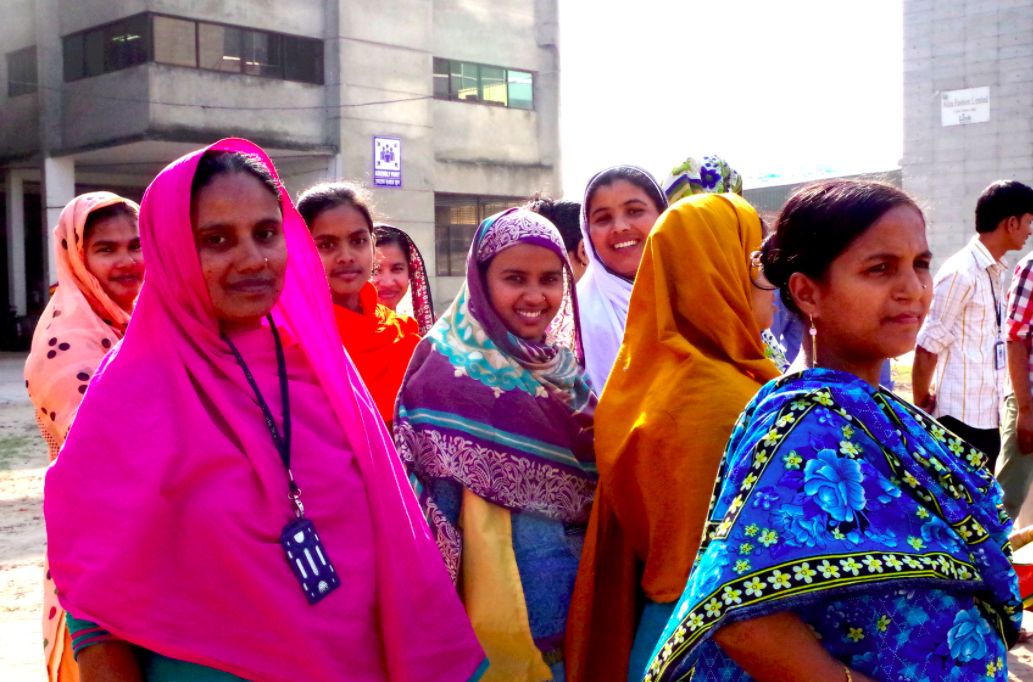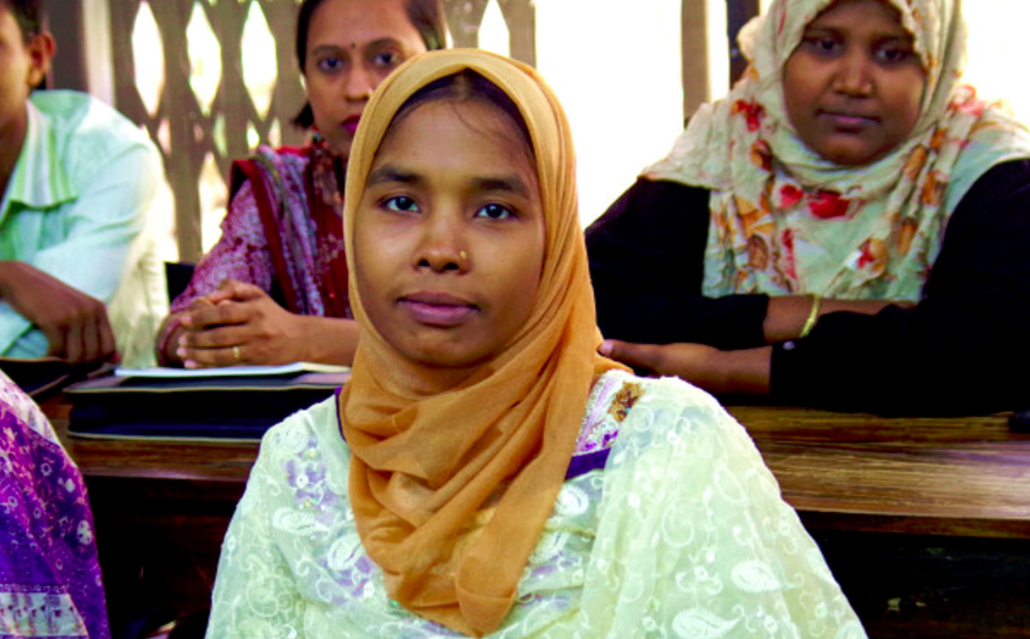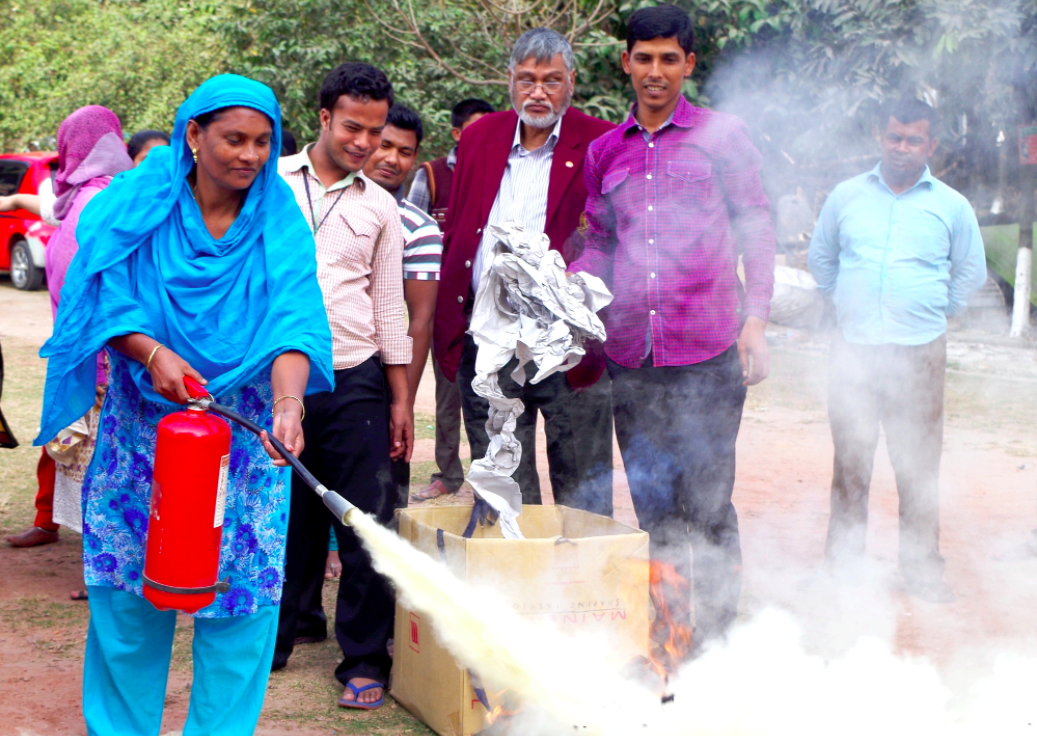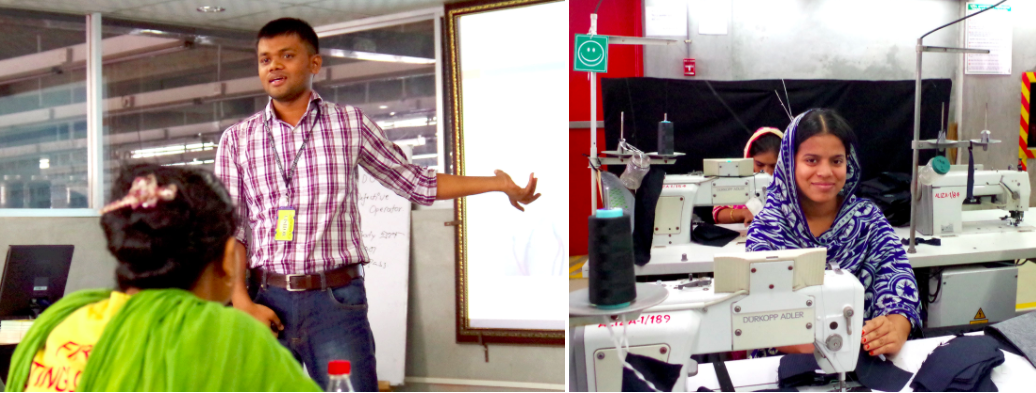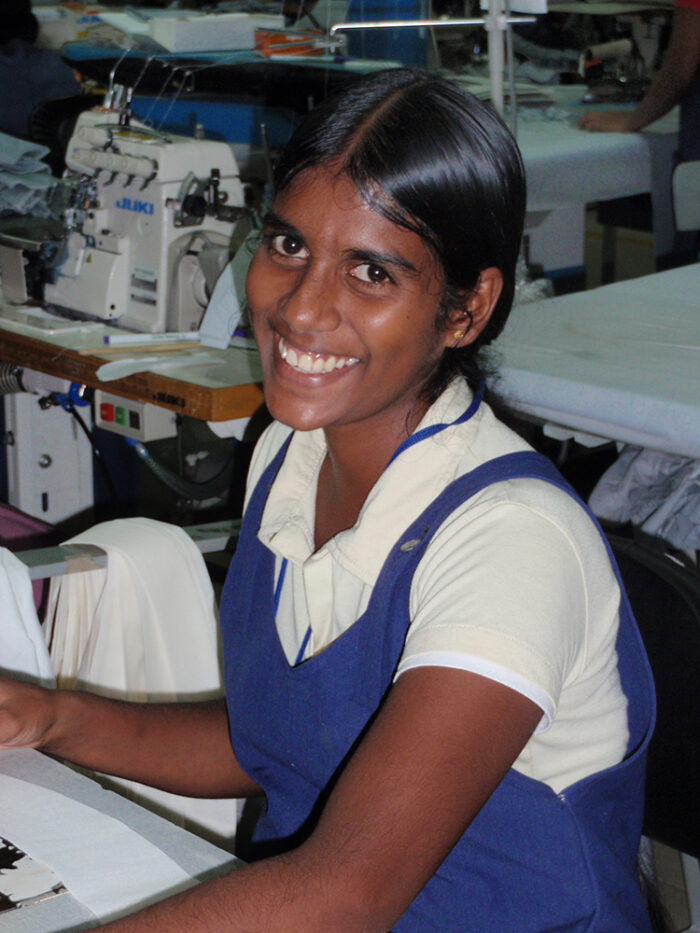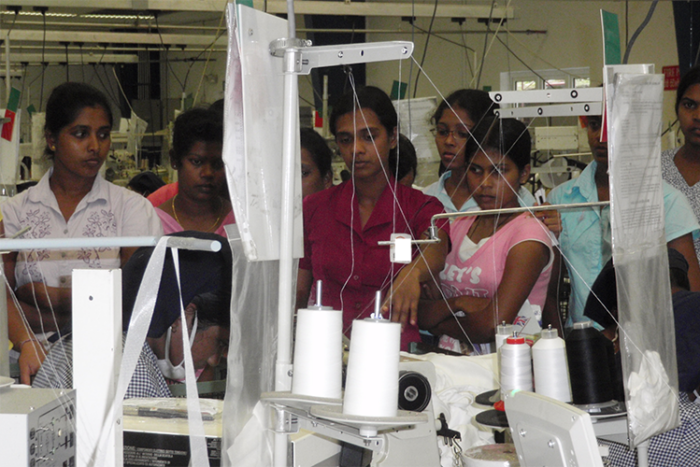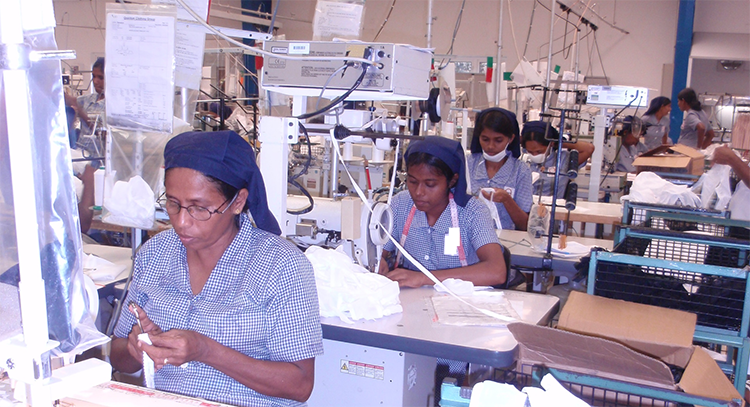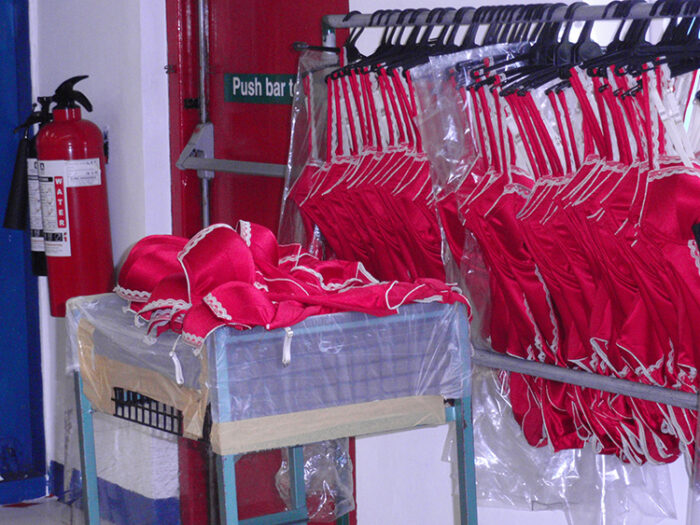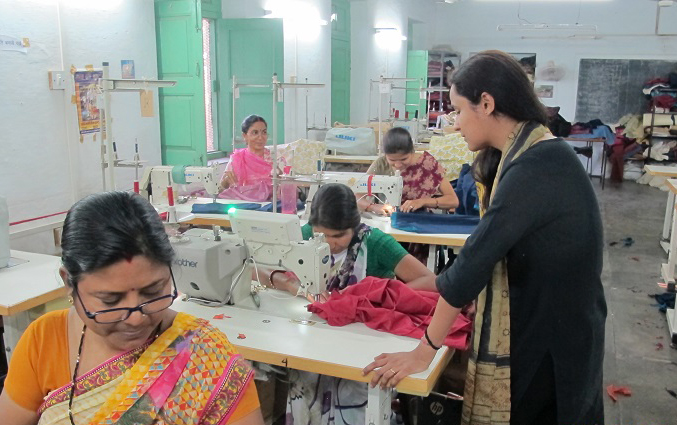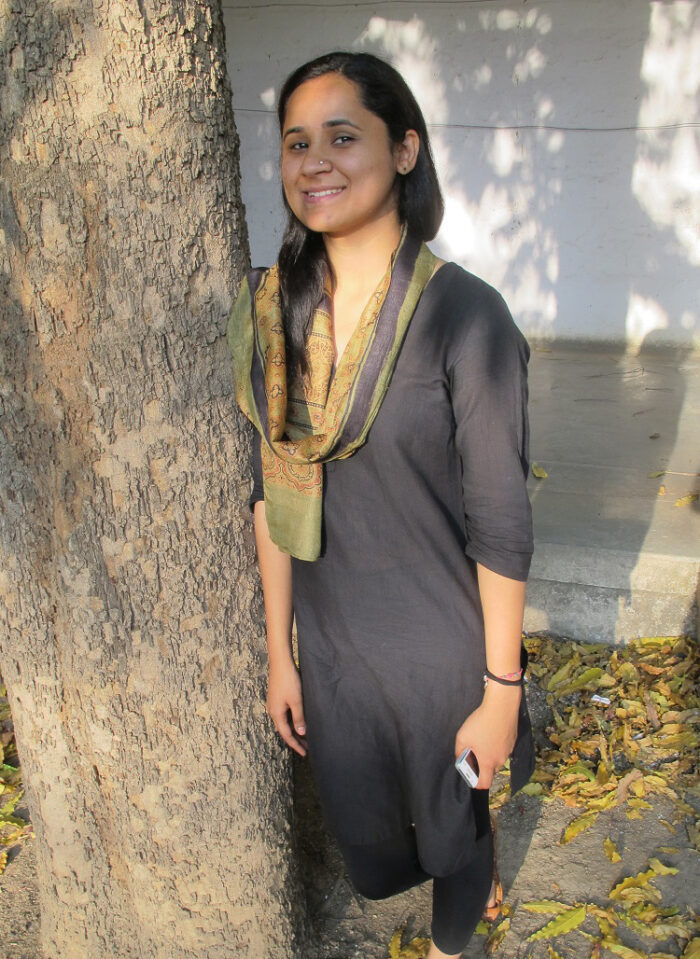Fair Trade Fashion From India
Secret Projects is a social enterprise working to ensure that women in India receive a fair wage for their work in the textiles industry. It aims to empower women by providing them with access to the global market for their skills and the products that they make: the final link in the chain they previously lacked.
Secret Projects now works with over 300 makers in six different states in India, making clothing a homeware. The makers are the most integral part of the business, and you are in invited to come and meet some of them:
Meet Lissy, our quality control expert. A former quality controller for Fab India, Lissy works in our Bangalore Production Support Unit checking all our products before distribution to ensure they are of the highest quality. We asked Lissy some questions about her work with Secret Projects…
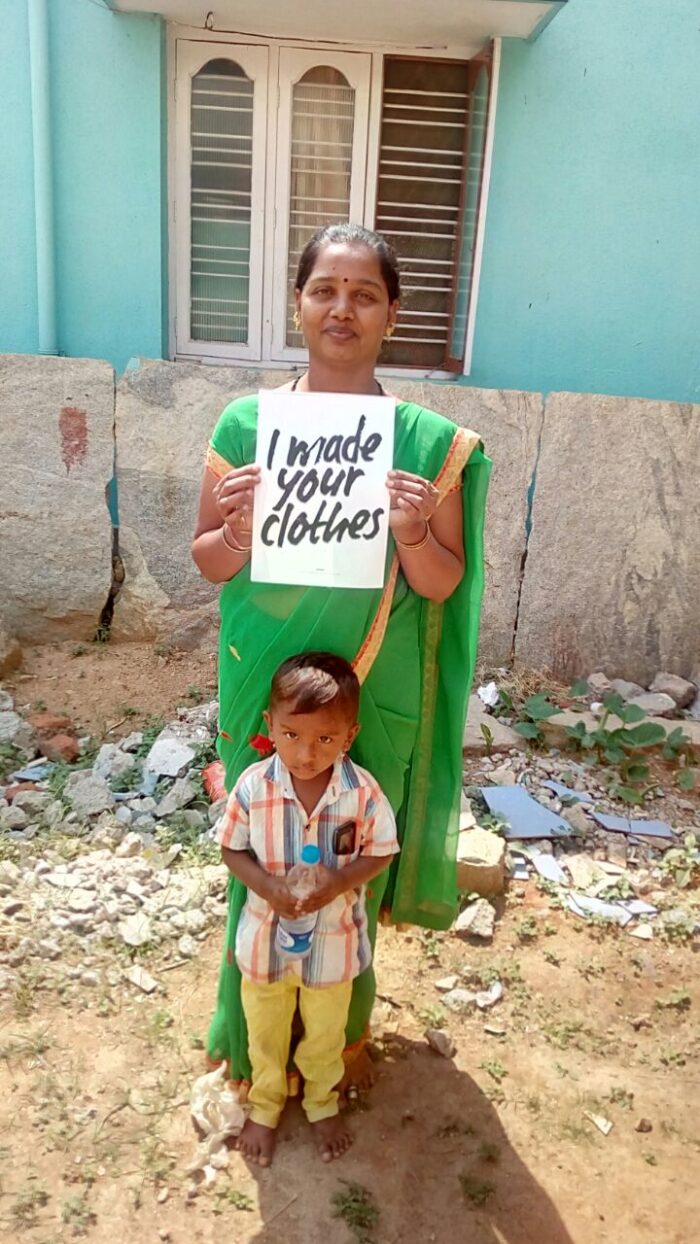
How did you become a quality checker?
I was working in the garment factory a helper for a year. My supervisor found me diligent and so asked me to take on the role of quality controller. I used to do the measurement and final quality check before products were sent out. This job requires following the entire cycle of the production. But I found the work in the factory very strenuous, and I could not manage it and my family at the same time, as I was never given leave. Then two years ago I came across Secret Projects, and I have been working here ever since.
What do you enjoy most about being part of the Secret Projects team?
I am able to work based on a timetable that is convenient for me. I am not in constant fear that I used to have in my previous jobs, as there is very good support.
What impact has being a quality checker with Secret Projects had on you and your family?
Personally, I am happy to be independent. I am able to manage my children’s school fees with the income. This has meant that I have retained my dignity, as I haven’t had to borrow money. I am no longer stressed, and I feel very happy.
How does it compare to other jobs you have had?
My previous jobs were always based on the management’s needs, whereas this job enables me to negotiate my timetable based on my own schedule.
Deepa is a member of our Bangalore Maker Network.
Deepa, how did you start sewing?
I have always had an interest in sewing, and my husband supported me to become a seamstress. I have been sewing for more than 10 years.
What impact has being a maker had on you and your family?
We were living in a very dilapidated house without much space at home. But through my income, we were able to save up and move into a bigger house that could also accommodate my sewing. This means a lot to me. I feel a sense of gratitude for what I have and am able to do. I hope in the future I can scale up my impact even more.
And what about your wider community?
I live in an urban settlement in Bengaluru. Members of my community often find themselves in distressing situations, and many of them are single mothers. There is a high suicide rate, as they often see no future for themselves. I can proudly say that I have been able to train many of them to sew, and they have found a new lease of life. Initially, when I train them, we support each other in the sewing and share the income. Once they are confident enough, they set up their own sewing unit at home, but it takes a long time to be able to save up to own a sewing machine.
I grew up in a small village. People there are very hard working but don’t have access to many job opportunities. I am keen to take Secret Projects to my village and share the opportunity that I have had with other community members. It would make me really happy to be able to do that.
How does it compare to other jobs you have had?
I used to feel hopeless and un-productive when I was staying at home and only doing household chores and staying at home. Now I feel that my life is so meaningful.
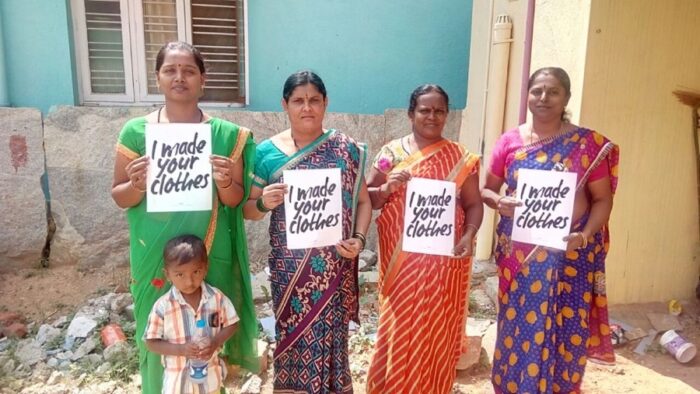
When Ubuntu Made first came to Maai Mahiu, we found a community of children with special needs and their mothers being mistreated and secluded. The stigma and lack of understanding surrounding special needs in Kenya means extremely limited access to essential services such as education, affordable healthcare, physical rehabilitation, and vocational training. This leads to limited opportunities for social inclusion, many social and economic issues for their families, and ultimately limits their ability to live the life of dignity that they deserve. Ubuntu first created the Ubuntu Special Needs Centre (SNC) to combat this stigma and injustice by providing therapy, education, and vocational training to youth with special needs in Maai Mahiu. Caring for these children had been a full-time job for their mothers, so soon after enrolling their children in the SNC their Mums started a new conversation with the founders: “Now that our kids are out of the house, can you help us do something productive with our time?”
The answer was a fashion line, initially imagined to create jobs for these Mums. Today, those same women have formed into a sisterhood revered in the community: women who provide for their families, purchase land, and venture into their own successful entrepreneurial efforts. Which is why it’s not simply about creating jobs.
“Plenty of people have been given opportunity, but they don’t feel empowered,” explains Zane Wilemon. “There’s something magical about our culture and creating a job within that; it then empowers the whole community.”
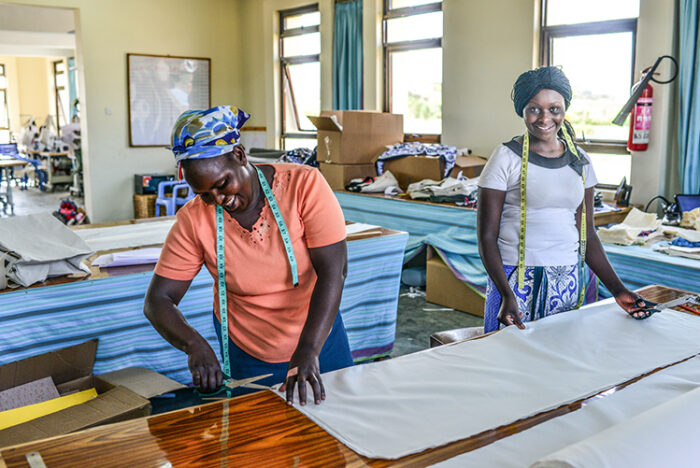
This conviction is what led Ubuntu Made to design and launch the Afridrille. At the intersection of customization and sustainability, the Afridrille merges customer experience with genuine connection. Based on the popular espadrille style shoe, their version marries modern on-demand manufacturing technology to an artisanal production process. Customers can choose from an incredible array of styles, choosing from a range of canvas colors, printed patterns, pattern colors, and African kanga linings. There are over 23,000 different design options, so each pair represents the personality of the individual customer. That means that each pair must be made to order, not produced in bulk in advance.
The key to making this process work is technology and expertise provided by Zazzle, a Silicon Valley company that makes customizing anything a possibility. They’ve applied their cutting-edge technology to enhance the customer design process and have dedicated hundreds of hours of senior staff time to help Ubuntu develop the new product, in a collaboration that re-defines what true “corporate social responsibility” represents today.
“At Zazzle we’re thrilled to extend our platform and technologies to Makers who craft products with soul, made from the heart. And there’s perhaps no better example of this than the Ubuntu Mums,” explains Jeff Beaver, Zazzle co-founder and Chief Product Officer. “Through our partnership with Ubuntu we’ve learned that providing economic opportunity is exponentially more impactful, and sustainable, than handouts or charity. These Afridrilles are more than just awesome shoes, they are a celebration of the human spirit, and every single pair empowers these Mums, their special needs kids, and their larger community. What’s better than that?”
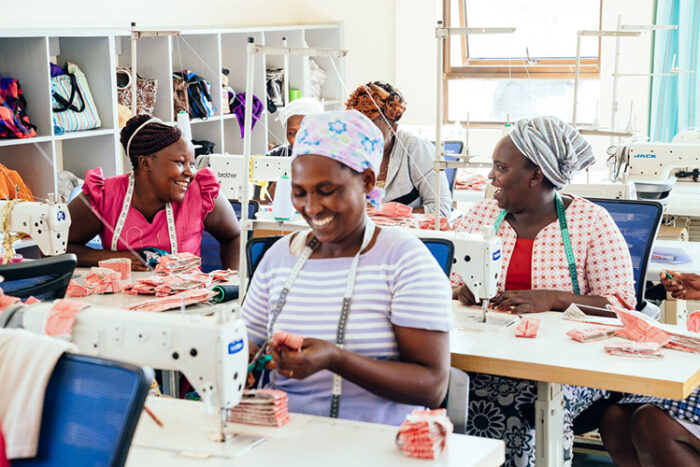
Crowdfunding the product launch via Kickstarter allows Ubuntu to build up production capabilities, expand the skillset of their ‘Maker Mums’, and perfect a complex operating process with the support of the Kickstarter community.
“Never underestimate the power of the entrepreneurial spirit and what can happen when people collaborate on something bigger than ourselves,” says Wilemon. “With the support of Zazzle and an eager crowdfunding audience, together we will scale up production and empower thousands of women and families in Kenya.”
At Ubuntu, empowerment means more than providing handouts or even a sustainable job. It means offering people a chance to create their own lives and livelihood. Ubuntu Made pays above-market wages to all of our employees – up to 4 times as much as they would have been able to find elsewhere in the community. We also provide health insurance to all our employees and their families, a rarity in Kenya where less than 20% have access.
The job skills our Mums learn and the money they earn empower them to buy homes – more than half of Ubuntu employees are homeowners compared to 1% nationwide. They are able to provide for their families, and sometimes start their own enterprises. They earn more than money; they earn respect in their community. Together, by providing disabled children with the healthcare and education they need, we empower them to realize their fullest potential.
That’s empowerment. That’s Ubuntu in action.
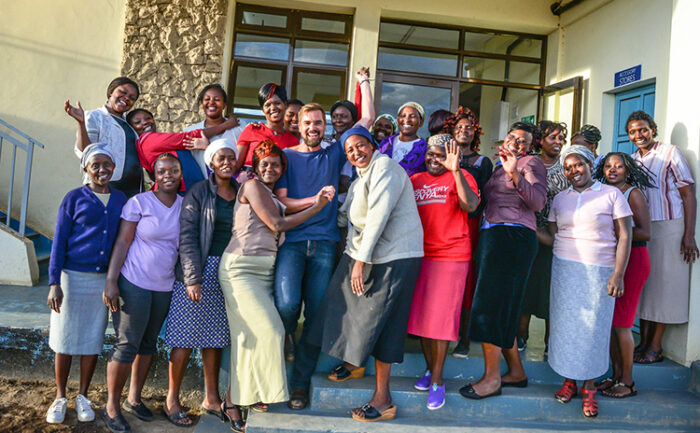
Strikes, Rents, and Wages
During the last two weeks of 2016, as consumers in the United States and Europe were donning their new holiday outfits, the garment workers who made those clothes in the manufacturing hub of Ashulia in Bangladesh were being arrested by police, and factory owners sacked workers by the thousands.
The heavy-handed actions were a response to workers’ protests against high rents and low wages. Garments workers said they could not pay rent and purchase daily necessities like food, basic clothing, and medicine on the paltry minimum wage of $68 a month. In response, the Government of Bangladesh’s Minister of Commerce Tofael Ahmed announced that the government would ensure that rents in the Ashulia area would not increase for three years.
Unfortunately, new data from Microfinance Opportunities’ Garment Worker Diaries shows that current rent levels are driving garment workers to accumulate debt in order to provide basic necessities for themselves and their families. Consequently, the government’s promise to hold rents steady is unlikely to provide workers with financial relief.
Debt for the Renters
We are currently conducting weekly interviews with 181 female garment workers who live in manufacturing hubs throughout Bangladesh, including 16 who live in Ashulia. Two-thirds of the sample are responsible for paying their household’s rent. Women who do and do not pay rent share many similarities. The majority of the women are married, and they have comparable education levels and positions in their factories, although those who pay rent are slightly older. The women that are married live with their husbands and children in one room with no bathroom or formal cooking area; those that are not share similar spaces with other family members or other garment workers.
The economic behavior of these two groups is as different as their demographic characteristics are the same. The data make clear that rent is a huge burden for the two-thirds of women who pay it, demanding 40 percent of the value of a monthly paycheck on average. These women purchase goods on store credit more than twice as often as the women who do not pay rent, borrowing goods each month with a value equivalent to almost 20 percent of an average paycheck. The goods they purchase are not luxuries – they borrow basics like food, soap, and medicine for themselves and their families.
Women who pay rent use more cash loans too – they receive cash loans once every two months on average compared to once every four months for those who do not pay rent. Women who pay rent borrow loans that are almost three times the size of the ones that other garment workers borrow. At $37, these loans are roughly equivalent to our garment workers’ monthly rent.
Debt, In Cycles
Women do not acquire this debt haphazardly or in response to unusual events – their behavior is cyclical. In the weeks between monthly paychecks, women borrow goods from store vendors and take cash loans, using the cash to purchase basic goods they cannot get on credit and to pay rent for the upcoming month.
Their paychecks make them flush with cash but only for a moment – in addition to rent, they have to repay their outstanding loans from the previous month. After paying their rent and these loans, they are short on cash, and the cycle of taking on and repaying debt begins again.
Holding Rents: Nothing More Than a Platitude
This cycle has the makings of a catastrophe. An unexpected event, like a medical emergency, could be devastating for women already living on the financial edge. Women who lose their factory jobs may be unable to repay their debts, forcing them to borrow from riskier sources, and pushing them deeper into a debt trap.
From this perspective, the Government of Bangladesh’s promise to hold rents steady is nothing more than a platitude, a promise that while garment workers’ rent-induced stress may not increase, it will not be relieved in the near future. Instead, the workers will continue to exist in a status quo defined by the pressure of borrowing to make ends’ meet and working 60 hour weeks to ensure debts can be paid.
by Eric Noggle
The Garment Worker Diaries is a yearlong research project that is collecting data on the lives of garment workers in Bangladesh, Cambodia, and India. Microfinance Opportunities is leading the project with support from C&A Foundation. Fashion Revolution will use the findings from this project to advocate for changes in consumer and corporate behavior and policy changes that improve the living and working conditions of garment workers everywhere.
Follow the yearlong study on social media #workerdiaries
By Allison Griffin for Remake
Few things are more powerful than a room full of women who have something to say.
As part of our Remake Journey we traveled 2 hours outside of Phnom Penh along dirt roads to a small school in the middle of rice fields, one of the few safe places makers are able to unite to talk about their rights without the police breaking up the meeting.
This gathering was hosted by Solidarity Center, to help makers fight for their rights. We learned that when big factories agree to cheap prices and tight deadlines, they often can’t meet these demands. So they ship orders off to fly by night operations–dark, dingy subcontracted factories where the conditions are the worst.
The women we met had sneaked out labels from the brands they illegally sew for including Zara, H&M and Tommy Hilfiger. It was dangerous for them to sneak these photos and labels out but they did it anyway, in the hope that we and you as readers would help them, to ask these brands pressing questions about why they worked such long hours for so little.
I had the honor of sitting down with one such maker, Char Wong. This is her story:
I grew up in a family of eight children raised by a single mother. I was a farmer before working in a subcontracted garment factory. I found work in a subcontracting factory to earn more money and provide a better life for my own family, but the pressure from the daily quotas is stressful and the money is not enough.
I support my 16-year-old son, 10-year-old daughter, my elderly mother, along with my husband who is a farmer. I struggle to feed everyone with the minimum wage and extra $2.50 a day that I earn. My mother has diabetes and her medicine costs $30 a month, over 20 percent of my monthly income. I also want to save money for my children’s education.
wanted a better life for myself and my family which is why I took this work. But life has become harder. I get paid per 12 pieces, but if there’s even one single error in the batch, I don’t get paid at all.
A few years ago, the factory would receive an order for a new design every two or three months, but with the new fast fashion cycles, it now gets more and more new designs in a shorter amount of time. Learning complex designs is very difficult and we get no training. Sometimes it takes two or three hours just to learn and the factory supervisor scolds us for any mistakes. The more time it takes to learn a design, the less time I have to meet the quota and the less money I make. I typically make $5 a day, but with the more complex designs, I only make $2 a day.
Sometimes I cry because I fear I won’t meet the quota and get paid.
Like most parents from all corners of the world, I want a better future for my two children. I hope to pay for their college education so that they can work in Cambodia’s government. Government jobs pay well and do not require hard physical labor. I hope that my children can be government leaders and help improve the conditions and rights of future garment factory makers, just like myself.
I am grateful for organizations like the Solidarity Center, who teach us about our rights. I am learning to speak up more. I want my story and my colleagues’ stories to spread to people throughout the world.
You being here, listening, makes me hopeful.
I definitely felt a lot of girl power throughout the day, both from our own all female crew and the makers we met. These women are not playing victims, but fighting for their rights and educating themselves on their rights. Speaking with Char Wong, I realized that the hopes she has are fundamentally no different from mine–for a fulfilling life. I hope as a designer, I can be a part of the change and that this story moves you to buy better. Together we can #remakeourworld.
By Allison Griffin for Remake
I am not nervous to speak with you at all. My life has been full of hardships. At this point I am not scared of anything.
We met Sreyneang, a woman who has been working inside a Cambodian denim factory for three years, but has worked in the garment industry for many years. We traveled back to her home with her after her shift in a vehicle similar to a tuk tuk, but larger and less put together. The motorbike pulled a wagon with wooden beams across as seats and you had to balance the weight of people sitting, so that it would not tip over.This or trucks with empty backs are what most of the makers in Cambodia take to and from the factory.
I’ve been sewing since I was 15, my whole life. My husband was a security guard but he got sick. So now my garment maker salary supports him and my two daughters.
I work two jobs. I get up early. Take my kids to school. Then I take transport to the factory. At night I work as a tailor to supplement my income. I usually work until 10 or 11PM at night.
My home village is 3 hours away but I have a small house I bought here, which is unusual because most of my colleagues in the factory are stuck renting from landlords who raise the rent every time our wages are raised.
Her home was at the end of a dirt road and there were a lot of children all around. It was one room with earth flooring and a woven mat and benches, but no beds or indoor plumbing, but it did have electricity. She said she saved up to buy this land and built this house because it was closer to work.
My daughter told me she would drop out of school and start working to help me because she knows how stressed I am. But I said NO. She’s 14. I want her to stay in school and have a different life than me. I want my daughter to go to a school like Parsons and become a designer!
At dinner, she bought water bottles for all of us, which was very kind because they are expensive. While eating dinner, Sreyneang said she usually has only two spoonfuls of rice for dinner. It definitely put things into perspective and you could see the direct effects of low wages.
Sreyneang said she felt blessed that she met us. She wondered if her life would change from this meeting. We parted ways with WhatsApp numbers, big hugs and promises for a future evening together.
The world is round and we are all sisters. I want designers to know of the hardships and suffering in my life, of makers’ lives and the low wages we get.
Four million garment workers, mostly women, toil in 5,000 factories across Bangladesh, making the country’s $25 billion garment industry the world’s second largest, after China.
Garment workers generally are paid low wages with few or no benefits and often struggle to support their families. Many risk their lives to make a living.
On November 24, 2012, a massive fire tore through the Tazreen Fashions Ltd. factory in Dhaka, Bangladesh, killing more than 110 garment workers and gravely injuring thousands more.
In the wake of this disaster, garment workers throughout Bangladesh are standing up for their rights to safe workplaces and living wages. With the Solidarity Center, which partners with unions and other organizations to educate workers about their rights on the job, garment workers are empowered with the tools they need to improve their workplaces together.
Learn more about the Solidarity Center’s work in the global garment industry
DISASTER STRIKES TAZREEN
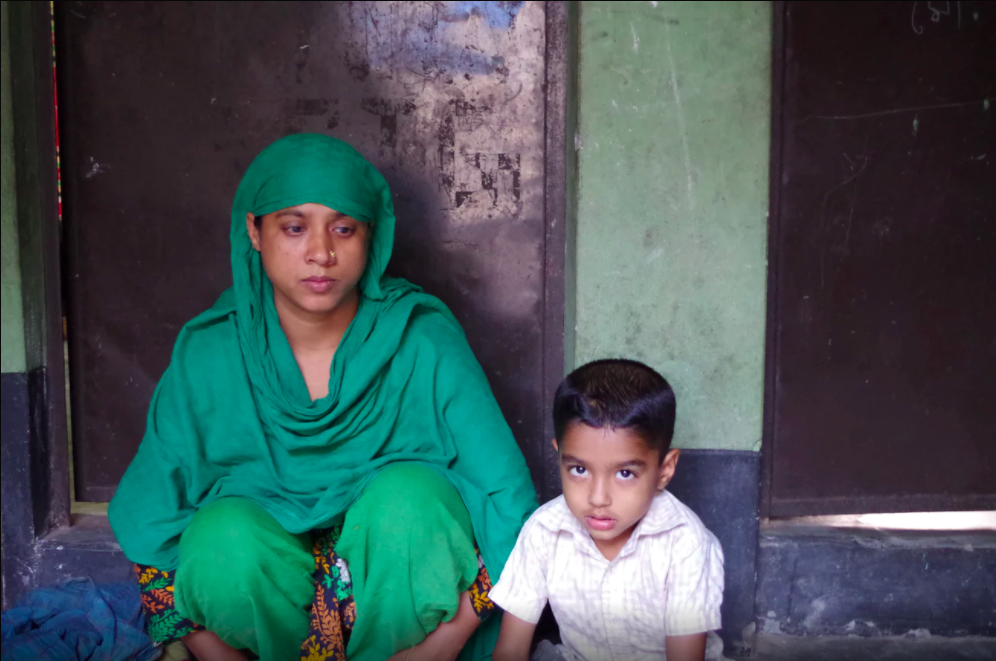
On November 24, 2012, women and men working overtime on the Tazreen production lines were trapped when fire broke out in the first-floor warehouse. Workers scrambled toward the roof, jumped from upper floors or were trampled by their panic-stricken co-workers. Some could not run fast enough and were lost to the flames and smoke.
Hundreds of those injured at Tazreen, like Tahera (above), will never be able to work again. Survivors say they endure daily physical and emotional pain, and often are unable to support their families because they cannot work and have received little or no compensation.
Some 80 percent of export-oriented ready made garment (RMG) factories in Bangladesh need improvement in fire and electrical safety standards, despite a government finding most were safe, according to a recent International Labor Organization (ILO) report.
TAZREEN NOT UNIQUE
The Tazreen fire was not an isolated incident.
Months after the Tazreen disaster, more than 1,000 garment workers were killed when the Rana Plaza building collapsed. Workers were forced to return to the building despite the warnings of structural engineers that the building was unsound.
In the four years since Tazreen, fires, building collapses and other tragedies have killed or injured thousands of garment workers in Bangladesh, according to data collected by the Solidarity Center.
FACTORIES CAN BE MADE SAFE
The Tazreen fire and Rana Plaza collapse were preventable. Workers at Tazreen and Rana Plaza did not have a union or other organization to represent them and help them fight for a safe workplace.
Without a union, garment workers often are harassed or fired when they ask their employer to fix workplace safety and health conditions. They are not trained in basic fire safety measures and often their factories, like Tazreen, have locked emergency doors and stairwells packed with flammable material.
Unions have helped to improve these conditions.
They have joined together to form workplace unions and bargain for safe working conditions, better wages and respect on the job.
UNIONS SAVING LIVES
Worker voices have yielded real results.
Over the past few years, the Solidarity Center has held fire safety trainings for hundreds of garment factory workers. Workers learn fire prevention measures, find out about safety equipment their factories should make available and get hands-on experience in extinguishing fires.
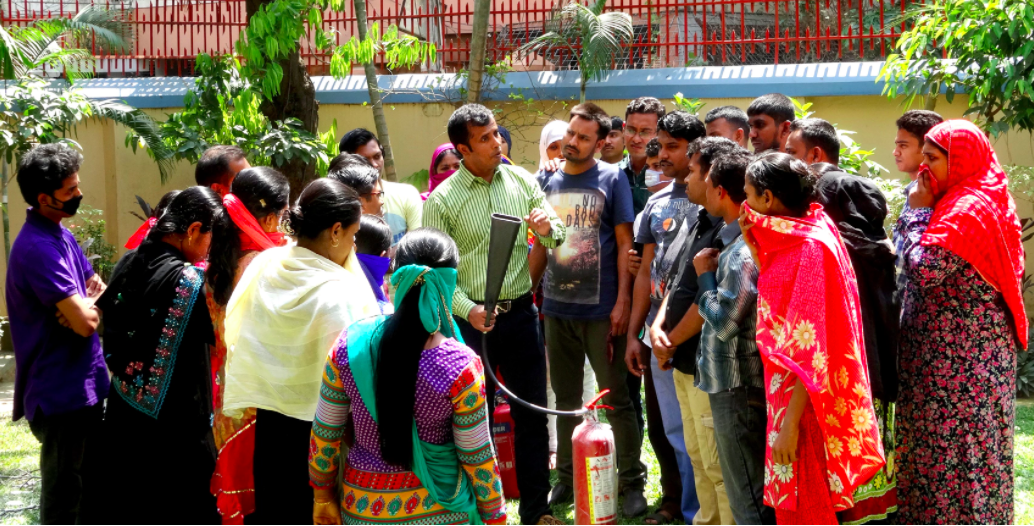
When women workers form unions, they improve their working conditions. Through Solidarity Center workshops and leadership training, more women are running for union office. Women now make up more than 61 percent of union leadership in newly formed factory level-unions.
CHANGE IS POSSIBLE
Salma (below), a garment worker, and her co-workers faced stiff employer resistance when they sought to form a union. With assistance from the Solidarity Center and the Bangladesh Garment and Industrial Workers Federation (BGIWF), to which their factory union is affiliated, workers negotiated a wage increase, maternity benefits and safe drinking water. The factory now is clean, has adequate fire extinguishers on every floor, and a fire door has replaced a collapsible gate.
To learn more about garment workers in global supply chains and how the Solidarity Center supports them, visit www.solidaritycenter.org.
It is not often that the life of Beyoncé and academic researchers intertwine – the chances are even more remote, when the research site in question, Sri Lanka, often rightly avoids the negativity associated with the global supply chain. Media reports record how Beyoncé justly supports the feminist cause for gender equality in pay. Yet by her braving into the world of branded gym wear (Ivy Park) to support and inspire women, she was opening herself to media scrutiny about how empowered its workers may be. While the media scrutiny may be warranted, the media’s representation of Sri Lankan workers is a partial rendering that flattens the very labour voices these interventions claim to champion.
On 8 May 2016, The Sun on Sunday carried a news item with the headlines that “Sweatshop ‘slaves’ earning just 44p an hour making “empowering” Beyoncé clobber”. Not being a reader of tabloids, I came to know of it, when an inquiry came my way from Broadly, requesting for input for a piece that it was being put together. In the hope for a nuanced intervention to the early news foray –from the Sun to the Metro, I assented. In the conversation with Siri Kale, we overviewed positive attributes to Sri Lanka’s apparel sector, signaling that it is ability to do so is associated with multiple factors – from a highly educated labour force to high standards in building regulations to protective labour legislative framework. All features of state policies in the social development and labour legislation; facets often downplayed in an age of corporate social responsibility. We also talked about the Achilles heels of Sri Lankan apparels – the lack of living wages and the inability of most workers to freely associate and enter into collective bargaining (i.e. unionise).
In the eventual output that came out of Broadly, the positives of Sri Lankan apparels or the potentially enviable Sri Lankan context was edited out. Hence, there was only one direct quote registering how MAS, a supplier/producer of Ivy Parks, has fantastic factories, is attentive to the built space, and how it is usually considered to be top of the supplier base in Sri Lankan. Otherwise, with a vaguely problematic title, the emphasis was on the lack of living wages and unionisation.
The absence of a living wage and the impossibility of unionisation are two points emphasised earlier in a report that came out of an ESRC-funded research, although there made within a context. I also emphasised how the positive adherence to ethical trade regimes and Sri Lankan apparels ability to do so having much to do with historical labour struggles, labour legislative frameworks and state policies towards our social development fabric. The centrality of labour geographies in making capitalism, à la Andrew Herod, was emphasised to accentuate how labour has agency in shaping capitalist development processes.
This nuanced reading of Sri Lankan apparels was met with wrath by an important union in Sri Lanka, with a pro-union friendly journalist hounding me with local media interventions in a bid to vilify the research. This stance was presumably because it dented the union’s ability to portray Sri Lankan apparels through a black and white lens. Shades of grey in labour politics was a faux pas, as a UCU academic member I was to learn – in a somewhat harsh way in my local research setting. Almost four years later, the partial rendering of my views by Broadly led to a message from a senior manager at one of my research sites to question my stance. While this communication was not unfriendly, I still had to point to him that the two lapses I had noted are already in the report that also helped his factory achieve a higher certification. It, however, made me then dig deeper into how this story had developed in the media.
From the Guardian to the Independent to the Telegraph, the emphasis was on Sri Lankan workers earning abysmally low amounts per hour, their slavery and the ability for consumers to change all these woes of the supply chain – where, according to the Guardian, Beyoncé was not to be blamed. Holding Beyoncé personally responsible for inequities in uneven capitalist development and the supply chain is simplistic analysis. This is beyond doubt. Yet the fact that the media and campaigners alike continue to promote the idea that consumers can single-handedly change the global labour division and continue to flatten the voice of labour by reducing workers to a homogenous category or to slaves is equally naïve. It is a representation that misses the very labour agency or conditions of possibility that made a single woman worker articulate views on empowerment and the lack thereof in her labouring life.
Feminists, Ethel Brooks and Dina Siddiqui, have emphasised this point previously and yet it continues to evade the attention of media and campaigners. The fact that Sri Lankan labour get paid a monthly minimum wage negotiated through a tripartite Wages Ordinance Board and hence are not paid an hourly wage or indeed a piece rate system was wholly absent from almost all media interventions. The woman’s description of her deplorable (private) boarding conditions is then stretched to categorize her situation as akin to slave labour. The elasticity of campaigner interpretations would require a leap of faith for any intelligent and careful reader. Nowhere in the public domain do I find the worker saying that MAS was providing boarding and that her mobility was severely restricted. Features usually absent in the Sri Lankan apparel trade, partly because many do not provide factory-based boarding facilities and partly because workers would not tolerate factories where they were locked up.
What then of Sri Lankan apparel workers? In contrast to the blasé narratives we are provided with, the reality of Sri Lankan labour is more complex and nuanced. Sri Lankan apparel sector draws upon an important and impressive social development agenda adopted by the Sri Lanka state for decades – giving the industry a highly skilled and educated labour force. It also draws upon relatively strong labour legislation, an outcome of labour struggles and movements from yesteryears, which thwarts the worst excesses of uneven capitalist development. These are facets that enable Sri Lankan apparels to make bold claims around producing “garments without guilt”; child labour, for instance, is non-existent in the industry because of state-provided free education and our legislation requires children to be in school until 16 years of age. Yet it also remains the case that with the weakening power of unions and gradual erosion to protective labour legislation, the risks for Sri Lankan apparels to fall off its cultivated mantle is real. The neglect of state protection towards labour given its absence of regulating private boarding houses or extending weekly overtime hours, equally matter in process of uneven capitalist development. Equally, so long employers have a stranglehold on the Wages Ordinance Board, worker wage increments rarely, if ever, have kept pace with inflation. The absence of a living wage then is likely to remain the Achilles heel of the Sri Lankan garment industry – making it potentially vulnerable to all other wild accusations, whether these hold water or not.
By Balmi Chisim, Solidarity Center
More than 1,100 garment workers died on 24 April 2013 when the Rana Plaza building collapsed in Bangladesh, a preventable disaster that injured thousands more workers in the world’s worst industrial accident in years.
Yet their lives likely would have been spared ‘if any of the factories (in the building) had a union’ says union leader Salma Akter Meem. Salma made her observation as she took part this month in a 10-week-long Solidarity Center fire safety training program, one of nearly a dozen such programs the Solidarity Center has held in the past two years.
Salma, 26, started working at age 14 in the garment industry. She says the Rana Plaza building collapse made her co-workers aware of safety issues, and they formed a union September 2013 so they could have a collective voice to create positive changes in their workplace, including making their factory safe.
Blocked from Factory for Trying to Form a Union
Forming a union was not easy, she says. The employer refused to recognize their union even after it received official government registration, which is required in Bangladesh. Employers retaliated against union members, especially against workers on the factory union’s executive committee, Salma says.
‘I was harassed and my union members were banned from entering the factory while we raised our voices and brought attention to the Accord that there was excessive machinery load on the floor and safety issues’ says Salma, who now is general secretary of the factory union.
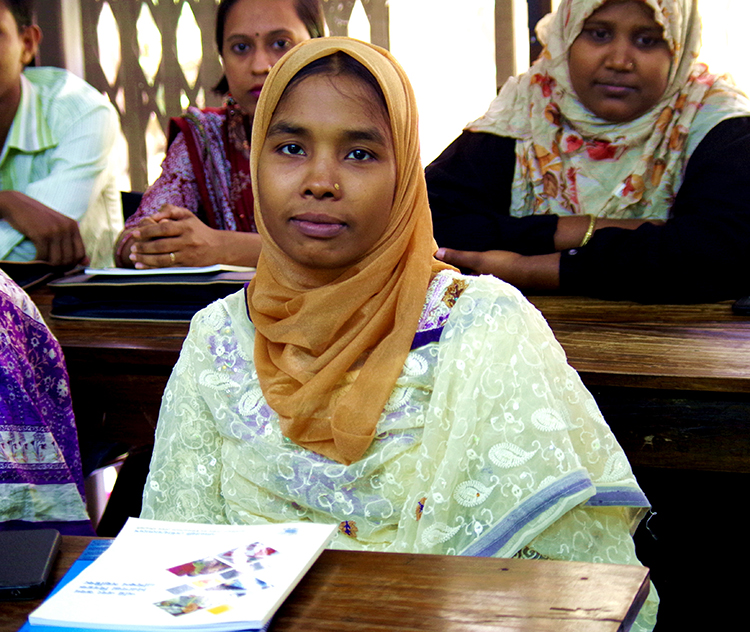
The Bangladesh Fire and Building Safety Accord, a legally binding agreement in which nearly 200 corporate clothing brands paid for garment factory inspections, was set up after international outrage over the Rana Plaza and the Tazreen Fashions Ltd. tragedy five months earlier, in which more than 100 garment workers were killed when the factory burned down. Since the Tazreen fire, 34 garment workers have been killed in fire incidents and 1,023 workers injured, according to data compiled by the Solidarity Center staff in Bangladesh, according to data compiled by the Solidarity Center in Dhaka, the capital.
Following inspections mandated by the Accord, dozens of garment factories were closed for safety violations and pressing safety issues were addressed.
Standing Strong Together and Winning
Even though some workers were not allowed to work after they formed a union, Salma and her co-workers did not give up in the face of such employer resistance. With assistance of the Solidarity Center and the Bangladesh Garment and Industrial Workers Federation (BGIWF), to which their factory union is affiliated, workers got their jobs back with full compensation for the time they were prevented from working.
Negotiations and discussions with management, finalized in February 2015, have resulted in positive changes, Salma says, with workers getting a wage increase, maternity benefits and safe drinking water. The factory now is clean, has adequate fire extinguishers on every floor, and a fire door has replaced a collapsible gate.
“Changes are possible if you have union and you can make it work.”
Back at the Fire and Building Safety class, Salma says she is ‘learning here not only for me, but also for my factory and family’. She says if workers are safe in a factory and not afraid to raise their voices for a safe and healthy work environment and living wages to support themselves, their workplace contributions will increase, benefiting the employer—and the country.
Header photo: Bangladesh garment workers take part in Solidarity Center fire safety training. Credit: Jennifer Kuhlman/Solidarity Center
Shubhangi Singh Rathore works as a Production Merchandiser at Sadhna Handicrafts in Udaipur, India.
As a Production Merchandiser at Sadhna, I follow up with suppliers and coordinate the organisation’s internal production related work. I love my work. I studied my masters in Fashion Management and took this particular work as a profession. I am now implementing and executing the theory and knowledge that I have gained from studying.
Before working at Sadhna, I was working in Delhi as a Buyer in the ladies ethnic department with Texas Pacific Group (TPG) Wholesale Pvt. ltd-Vishal Mega Mart. They’re the biggest private equity firm, owning Visual Mega Mart, one of the biggest retail chains in India. It’s huge. That was my first job.
When I was a child, I thought I would become a naval officer! I used to watch a television program that used to play on Doordarshan and the name was Abhiman, which was based on the navy. My career aspirations changed every now and then, but that was the very first initial idea in my mind.
Soon after my graduation I got more inclined towards brands. This is because my friends were very brand savvy. Until the time of graduation, I was not a very brand savvy person. After meeting my friends who were quirky, I started hearing words like Zara, H&M and Abercrombie and Fitch. It sounded to me like there was a big brand garment industry out there.
My mum always used to compliment my eye. She would say I have a great taste in colour combinations and styling. Even if not always in regards to my own styling! So I thought fashion industry was a good choice for me to pursue a career with.
When I started my career in fashion I worked as a Buyer, now I am on the flip side, I am a vendor. When I was a buyer I was dealing with the vendors and regularly facing some challenges, such as with vendor management, timely deliveries and sales at better mark ups. On the other side, I know what the challenges are. Now with the blend of both jobs, I am able to bridge that gap. It’s not ethnic, western, whole, woven or knits, it’s about the knowledge that you acquire and gain and using this to get better designs. I will stay in production and upgrade my skills.
I decided to come back to my home town as it had been quite a long time away with my studies, internships, working and everything. I found some work in my own home town within the fashion industry. I was so lucky to get associated with Sadhna.
Five years down the line I see myself as a Category Head. This could be either with Sadhna, if it grows and thinks of having Category Heads in the future, or maybe with another brand.
As a Buyer, I have been to places where there are women operators and male operators. In other factories and setups I have been to people are more confined. They enter work and go. At Sadhna it’s more of a family. I feel whatever thoughts you have in mind when walking into the factory you can share it easily with another person. Here through chatting people can shed off their office and home load and when they exit, they take happy memories. I always notice that with the tone when the pitch is high everything is normal. Sometimes I witness quarrels, but it’s when people speak in whispers, “I think something fishy is going on!” When the buyers visit they hear shrieks and are like “my god, what is all the noise?” and I say “chill, we are laughy, chatty and noisy like a family!” Still, people work very hard. Sadhna keeps the balance between the corporate and social sector. We completely do not want to operate a corporate factory with no emotions. In terms of output and systems we are trained and documents are recorded. All the teams have documents, instead of documentation being in a person’s mind. We give more and more training on this. Even the work that I do, the coordination and follow ups, I always tell people this file contains these items, if I am not here you know how to document it.”
My previous boss, Mr Bharat Bhatia, was my role model. He had 16 years’ experience with knits and was a person who used to see a garment from the distance and be able to tell the price of the garment. In Sadhna, I admire Swati for her overall production handling expertise and Manjula for skills in handwork. Every now and then I make somebody new my role model. In the movies, I like Ahmed Kahn. I really like Sushmita Sen who was an ex Miss Universe. She is beautiful and independent and she is a single mother, very known. She is doing very big things for society but not that many people know about it.
There are so many challenges for working women in India today. Firstly, the society is the biggest challenge, then the family is the second one and the inner consciousness, which has been made stubborn, is the third one.
In Indian culture everything is a blend with the society. Society pesters every now and comes up with thoughts and with facts, which pressurizes a woman to change her decisions. I will give you an example, suppose if girl is aged 22 or 23 and further wants to work, the society will keep pestering the parents saying “this is her marriageable age, you should marry her off, why aren’t you marrying her?” or they will say “that girl got married, this girl got married, why isn’t your daughter married?” The society is always pressurizing parents and then families are pressurizing girls and women.
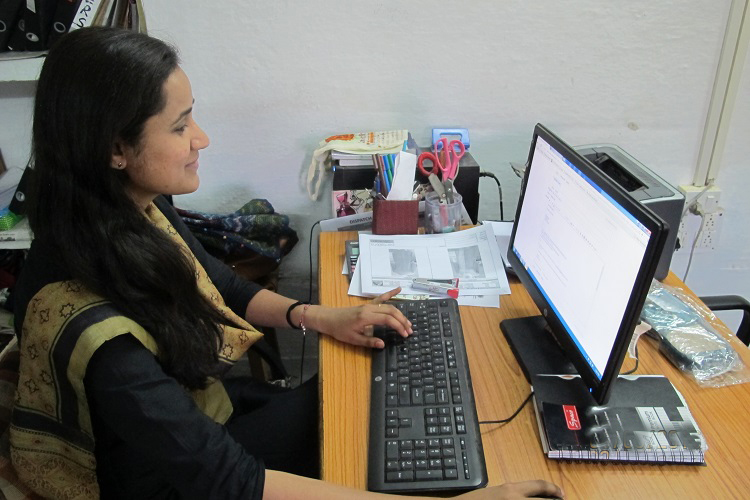
Inner conscience is meant in the sense that some girls know what they really want to do. But they then limit themselves and they create boundaries, therefore they never do what they really want to. If women really want to travel they should! But women won’t do it because the inner consciousness keeps telling them “you are an Indian girl, you don’t have to travel, you just have to be at home and if you want to travel it should be just 20kms to-and-fro, not more than that”. Women who do travel on their own in India are great. But generally, they are at home but travelling to fetch the wood to cook at night, they get water from the pumps, which is actually more travelling than men. But not enough in the outside world and women really want to travel more.
Personally, I would love to travel more, I have been doing it quietly, and especially when I was away from home I would travel to find out more about different cultures, meet people, learn songs in local languages and take lots of pictures! Now I am home, again you see it’s the inner consciousness that tells me: “how do I tell my parents I want to go out? I have to come up with reasons that I have planned a party or I have planned a vacation”. When I was living outside of my hometown in hostel, I didn’t need to explain. When you are at home, you are in front of the eyes of your parents and they keep a note of everything.
The main challenges for women in India are to work as per their choice, to marry as per their choice, to decide whether to stay in a family or to stay all by themselves, and studies, choosing disciplines as per their choice. There are more women studying now in India but difficulties still remain.
For International Women’s Day, Sadhna is planning an event on 8th March. We will play some games, to make the women feel special. Before I started working with Sadhna, I was not familiar with the views of “for the women, of the women, by the women,” I’d heard them in a democratic sense. We need to expand these prepositions with women. I want everyone to feel proud to be a woman that would be my message for International Women’s Day.
Ding (left) explains his life philosophy to researcher Mikaela Kvan (right) stating, “I will work until I can’t. That is how I will live my life.” Photo by Daniel Huang
Shenzhen developed earlier than other cities in China so there were many more opportunities to find work here when I first arrived. I came here along with other migrant workers. I didn’t think I would stay here for long but it ended up being 20 years. I have been in Shenzhen for 22 years. Before I married, and when I was young, I lived in cities all across China. I am originally from Jin Jiang in China’s northeastern Jiang Su Province. I go home once a year for the Spring Festival.
I work in garment factories pressing clothes before they are packed for distribution. I’ve had this job on and off over the course of my life. My very first job was as a presser. Soon after, I graduated to a managerial position doing logistics for 20 years. Now I am back to my old job. It’s harder but I have more flexibility and less pressure.
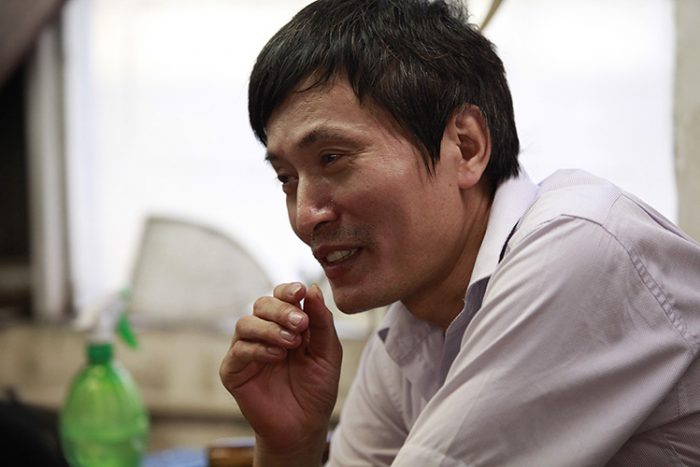
My wife doesn’t live here with me. We used to live together but, when our daughter started junior high school, my wife left to be with her. Our daughter’s teacher called to tell us she was not doing well in school. As parents we want our kids to have a better life than we do and we want them to achieve something. I don’t want her to end up doing physical labor like us.
Now our daughter is 28th in her faculty at university. I am relieved to see her doing so well. She is a good kid and I am proud of her. She studies information engineering at Nanjing University. I’m not sure what her future holds, because it is up to her. She may not be able to make a lot of money because getting rich partly depends on luck.
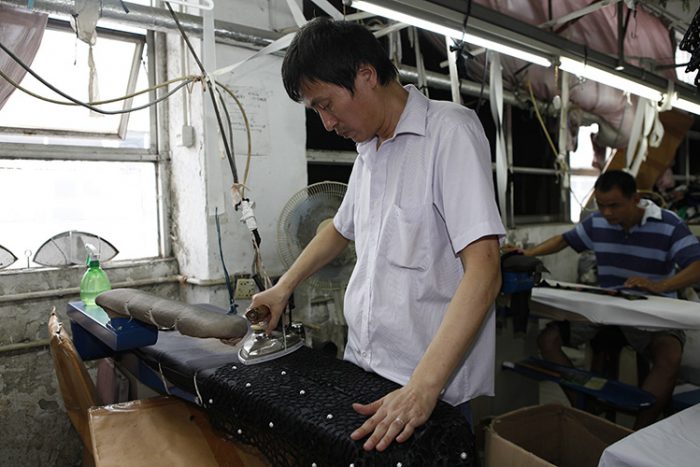
Earlier this year she was selected as one of ten students to study abroad in America. There was a test to select those ten students. Those who aced the test could go. The school will pay for half of the expenses and we will cover the other half. So far, my wife and I can afford it. We are a bit strapped for cash, but I haven’t worked excessively because health is also important to me. If there are orders coming into the factory and us workers have the opportunity for lots of overtime then I can just stay here. However, if there is no overtime at this factory then I will go to other factories to do the same work. I just don’t take any days off. That includes Sunday. I see a bit of myself in my daughter. She is hardworking.
The reason I stay so disciplined in my work is my child. I want to provide for her. I believe you can do anything you want as long as you have money, but you can’t do anything without money. When my kid finds a job, builds her own family and everything is settled for her, only then will I go back to my hometown. I’ll find a job there so my kid doesn’t have to support me. I don’t want to burden her and I want to lift some pressure from her shoulders. I will work until I can’t. That is how I will live my life.
This interview has been edited. It was originally conducted on July 13, 2014, in Yantian, an industrial area east of Shenzhen, China. Read the full story here
Primary Voice is a collection of primary source interviews dedicated to documenting the living stories of garment factory workers worldwide. It was created by urbanist Mikaela Kvan. To read more interviews and to get in touch visit www.primaryvoice.org
Channa needs to spend over 300USD per month on food to feed her four children, chronically ill elder sister, husband and herself. Photo by Sok Chanrado
I’ve lived in Phnom Penh since 1992. My hometown is in Prey Veng Province. Where I used to live in the countryside, it would flood every year. I couldn’t find food to eat and I was an orphan. I moved to Phnom Penh to live with my sister so that I could work at a factory to feed myself. Phnom Penh had and still does have many more job opportunities than my hometown. I like living here for that reason.
The things I value most in life are having enough food to eat, and living together with my children and husband. I want to be able to send my kids to school everyday but financially I can’t. Simply speaking, when you don’t have money you cannot do anything. If I want my kids to go to school I have to look after my younger daughters, but then I can’t go to work.
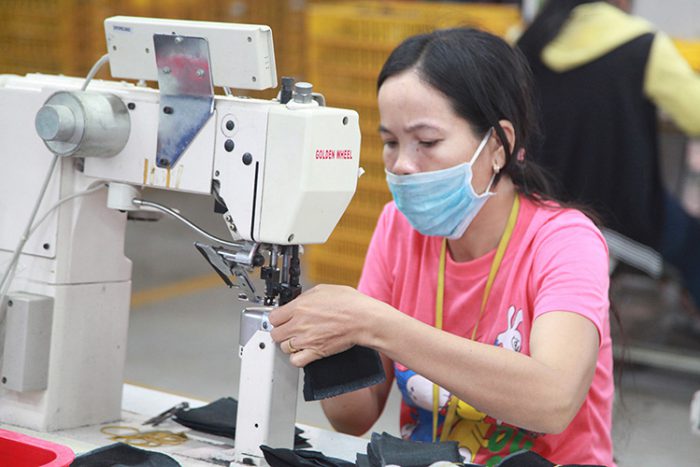
My husband is a construction worker. Both of our wages combined are not enough to live off of. Plus, I have another mouth to feed – my elder sister. When her health is good, she will help out by taking care of my younger kids. If she doesn’t feel well, my elder sons must take care of their sisters and cannot go to school.
Despite our best efforts, things haven’t worked out the way we wanted. For example, in 2012, when my youngest daughter was born I couldn’t work and I didn’t have anything to eat. I had a big fight with my husband. It’s normal for a couple that lives together to argue often. After our fight one of my friends asked me to move to the border of Cambodia near Thailand but I didn’t go. I decided to go to an orphanage to ask for a place to stay instead. They did not let us stay. I didn’t know what to do, so I sold all of my stuff from living in Phnom Penh. If you can’t work you can’t live. I thought if we were in the provinces people would help us out so we moved to Sompov Loun for about five or six months. But then my kids became allergic to the land there. I didn’t know what to do. I asked another orphanage to let my kids learn at their school but my kids weren’t accepted because they weren’t orphans.
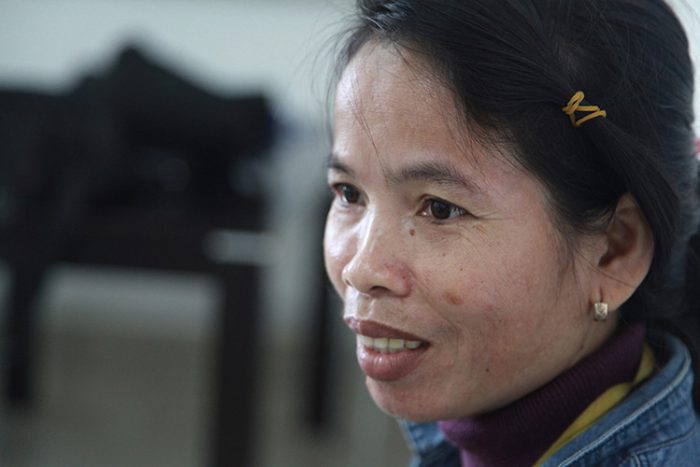
In my opinion, if your kids are educated they will think about and respect you as a mother. I have seen kids on my block beat their moms, cursing them. Kids nowadays have no manners or respect whatsoever. I hope and believe my kids, whether they are educated or not, will think about me as a mother and I can depend on them in the future. If they are educated though, I believe I can depend on them more. My 14 year-old son is a good kid. He does house chores, looks after his sisters and listens and obeys well unlike rich kids his age. I think a kid from a humble family is better than a rich kid in terms of character.
I believe my kids would have a bright future if they could go to school regularly though I cannot afford for them to do so. Think about it. I have to spend 10,000 KHR (10 USD) – and it’s not that small of an amount – everyday for food. So my monthly expenses for food is 300,000 KHR (300 USD). Not to mention, I have to pay for rice, utilities, rent, and so on. If I let my kids go to school regularly, I cannot make it at the end of the month.
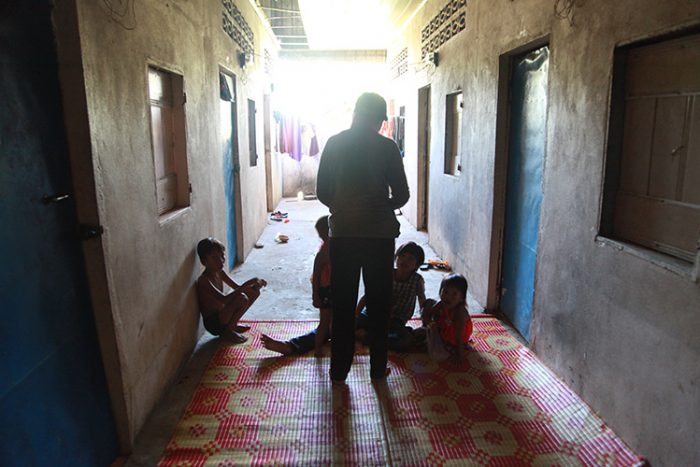
My kids want to learn English, but I cannot let them. All I can do is buy a book for them to learn at home. I asked the teacher whether my kids were smart in school and they said my kids were the best. Both of my sons are the best. It’s my sin from my past life that I cannot afford for my kids to go to school. But unlike other mothers who do not care about their kids’ progress in school, when I get home from work, I always ask my kids what they learned that day. Since I have no inheritance for them, as a mother, that’s all I can do for them.
I think about my life all the time. My mother passed away when I was young, just six months after giving birth to my younger sister. I thought I would never get married if I couldn’t make enough money. We came to Phnom Penh after I reached puberty and my sister was a bit bigger. Our financial situation was better because my sister was working. But then I got my first abortion and got married. After that, my father died and my older sibling sold our land. That was when I had another abortion, my third child. We’ve been poor since then. I’ve been praying to god asking for help but nothing happens.
Yesterday or the day before yesterday, the school called for a parent-teacher conference. I went and they asked why my kids have stopped coming to school. I told them it was because I was poor. And then they asked why I became a parent if I had no ability to raise a child. I replied, “What was I supposed to do? I tried my best but it didn’t work out. Should I just rob or steal to make it happen?”
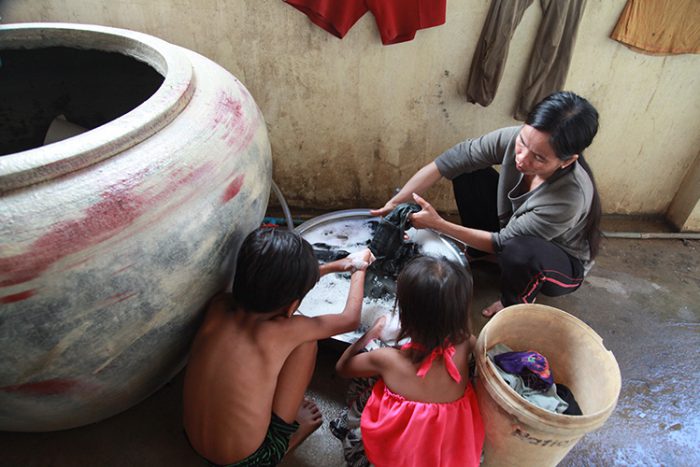
For example, when he gets his paycheck, he knows I need the money, but he only gives me some. You know men nowadays; needless to say, they are…tears come to my eye when I try to talk about this. My sister lives with us and he’s not happy about it. That is why he always picks fights with me. He is also younger than me. He’s still young and beautiful. That’s why. He loves his kids though. He hangs out a lot outside with his friends and stuff, so he always finds faults in me, but he never beats me.
I had a fiancé who was a widower before I met my husband. My husband worked on the construction near my factory. One day he asked me for some water. Then he touched my hand and I was like, “Why are you so rude? You don’t even know me.” After that, he followed me around and came to my house to ask for my hand in marriage. At that time, my late father was still alive so he advised me to think it over between a bachelor and a widower. He said it was better to live with a bachelor. Since I didn’t love either of them, I just followed my father’s advice and got married to my current husband. But it was only ten short years of happiness. After my first abortion, ten years later, things got rough.
The way I see it, if your parents are alive you dare not refuse their advice or complain. If you follow your parent’s advice you will blame them for your unhappiness. However, that is not the case for me. All I can do is be regretful and accept this decision as a sin from a previous life. If my father were alive, I would blame him as well for his misjudgment. I just feel sorry for myself. My life is an endless sad story. I don’t want to talk about it anymore.
This interview has been edited. It was conducted in two parts. The first took place on August 4, 2014. at the shoe factory where Channa was worked. The second time we met was on August 9, 2014, at the apartment complex where she lives on the outskirts of Phnom Penh, Cambodia. She quit her job at the shoe factory. You can read the original interview here
Primary Voice is a collection of primary source interviews dedicated to documenting the living stories of garment factory workers worldwide. It was created by urbanist Mikaela Kvan. To read more interviews and to get in touch visit www.primaryvoice.org.




